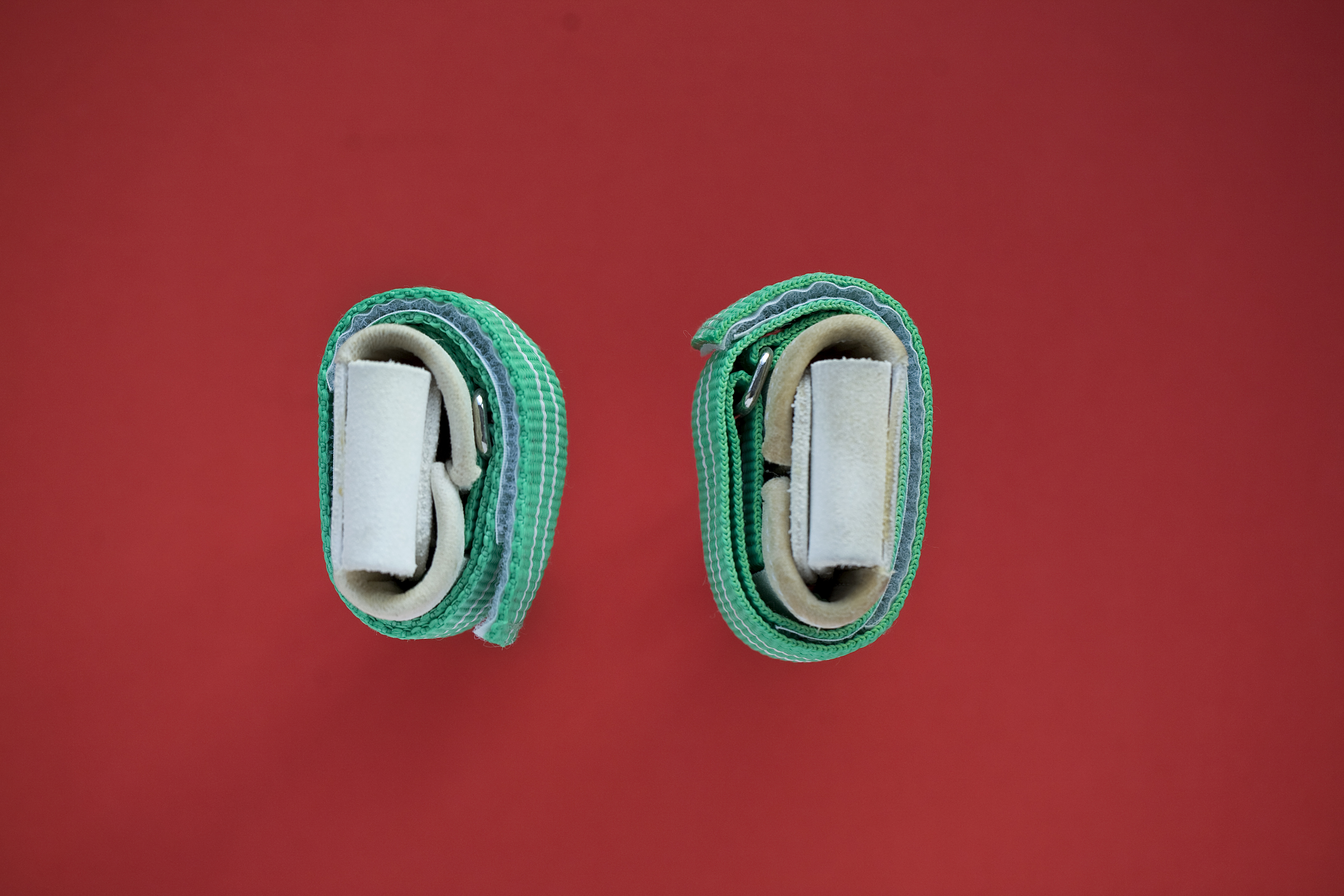‘It’s a great feeling to fly, to twist, to rotate’

Although his profession is teaching business, Reto Marthaler’s passion is gymnastics. He spends hundreds of hours per year organising local and regional boys’ programmes. The sport is on his mind “every day, every hour, every second”.
Marthaler sits on a mat facing six small boys in gym attire. He speaks quietly, earnestly. “What do you think? How many times do you have to practice a front flip before you can do it?”
“Seven?” suggests one boy.
Marthaler shakes his head slightly, a hint of a smile on his angular, unshaven face. “More like 1,000,” he replies.
It’s spring break, and the gym in the school just outside of the Swiss capital Bern is full of seven- and eight-year-olds. The boys are doing a week of intensive training on the gymnastics equipment that fills the hall. Marthaler and three other coaches are spending their vacations in the gym as well.
For someone who hasn’t grown up with the sport of gymnastics, spending vacation in a gym might be hard to understand. But for many people – like Marthaler – gymnastics is a lifelong activity. Ex-gymnasts go on to become coaches, and their own children often become gymnasts as well.
Marthaler’s personal life is pervaded by gymnastics. He met his partner, the mother of three gymnasts, in the gym, and the children “are doing gymnastics seven times a week. They have four weeks a year without gymnastics,” he says.
Students and sports
When not on “holiday”, 34-year-old Marthaler teaches economics, law, and business at one of four public schools in and around Bern that prepare teenage students to go on to university. He also has a degree in sports education, but during his year as a teaching apprentice he found that many teenagers were not very motivated sports students.
“They have to go to the gym, and about half of them don’t really like doing sports,” he says. “That was quite hard for me, and it’s also the reason I’m not teaching sports at the moment.”
As a young student himself, Marthaler loved mathematics, computers, and . . . sports. He grew up in the small village of Oberscherli, a few kilometres outside of Bern, and spent his childhood calculating (“I could fill papers with numbers”) and playing outside with his younger sister and the only other child in the five-house neighbourhood.
“We had the forest, we had fields, we had a lot of sand dunes where we could play,” he remembers.
At the age of eight, Marthaler began doing artistic gymnastics – an Olympic sport – at a local sports club. “Already at that time that was pretty late. Today it would be extremely late, even too late,” he says.
Gymnastics shoes
Today, children typically start gymnastics at the age of four or five. Gymnastics is “absolutely the best sport to learn gross motor skills”, says Marthaler. “You have everything from strength to flexibility to speed to coordination.”
Since 2000, Marthaler has overseen a Saturday school programme introducing boys and girls to the basics of the sport. Over the years, around 1000 children have taken part. Marthaler knows firsthand that “it’s a great feeling to fly, to twist, to rotate.” And coaching is “very motivating, because all the time you have new challenges for yourself, how to teach something new.”
In 2002, along with two fellow gymnasts, he took over the programme at the gym where he got his start, stepping into the shoes of his own coach, Franz Meier, who was diagnosed with cancer.
“All the time I did gymnastics at Bern Berna he was my coach,” Marthaler says. “More or less he was almost my grandfather, because I spent such a lot of time in gymnastics. We were very, very close.”
Younger and younger
In the beginning, Marthaler and the other two coaches had “absolutely no idea” what running a gym was all about. Eleven years later, Marthaler has loads of experience.
In 2012, in addition to his two other volunteer positions, Marthaler was named head of the boys’ programme at Bern’s regional training centre RLZ, located in a renovated horse stable on the grounds of the National Equestrian Centre.
The 500 m2 RLZ is the main training location for area gymnasts striving to qualify for the Swiss national team. Here, talented young boys and girls up to age 15 practise up to 25 hours a week with professional trainers – most from Eastern bloc countries. At present, 16 of the boys were referred by Marthaler.
The long, narrow structure is filled with mats, balance beams and parallel bars. Marthaler sits on the chalky end of a sidehorse, dressed in a purple sweatshirt and jeans, watching the activity. There is a thudding sound as a boy with a taped knee punches off a beat board and flips past his trainer. The air is dusty with magnesium, used on the hands of the young girl doing giant swings around a bar mounted high above the floor.
Here, Marthaler is not a coach but an administrator. He is responsible, among other things, for identifying children who could be Switzerland’s future gymnastics stars.
Discovering exceptional athletes is a very time-consuming process, he says. In past years he visited “about 50 kindergartens… and it’s an extreme amount of work to find one talented boy or girl.”
The search is ongoing. In 2012 Marthaler helped launch an open gym programme at the RLZ. There, children and their parents can explore and experiment twice a week for a small fee, playing on the equipment under supervision. The programme is a huge success. The target age? One to four years.
Future planning
There is generally a great deal of interest in the sport of gymnastics in the year following the Olympic Games. Gymnasts invest at least a decade in training before reaching a level where they can compete internationally. Often, they drop out because the effort becomes too great. Or because their parents didn’t realise how much time and effort would be involved.
Swiss gymnasts often aren’t as driven as gymnasts in other countries. Marthaler, with the perspective of a teacher, says: “We have talented children, but the most important thing here is school. And that’s good.”
Still, although he is a teacher by profession, his world revolves around his hobby. “I have a partner involved in gymnastics. On my desk everything is gymnastics. On the computer is gymnastics. Most of the e-mails coming in are because of gymnastics. I’m thinking about gymnastics, about my plans and ideas, all the time.”
One of those plans involves the RLZ, which is bursting at the seams. Regional centres in other cantons are huge in comparison, and many are new, built with local funding. One of Marthaler’s goals is to build a 2,000 m2 gym for Bern in the next two years. Around CHF3 million will be needed.
“As usual, if I’m planning something it’s quite optimistic,” he says wryly.
Marthaler has already given the sport of gymnastics around 10,000 hours.
Does he ever relax? There is a long pause. “Actually, it’s really a problem,” he says. “As long as I see that something has to be done, it’s really hard for me to relax.”
Delegating is also difficult. But “I’m making progress there,” he says with a rueful smile.
Artistic gymnastics has been an Olympic sport since 1896 in Athens (men) and since 1928 in Amsterdam (women). There are six events for men (vaulting, pommel horse, still rings, parallel bars, horizontal bar and floor exercise) and four for women (vaulting, uneven parallel bars, balance beam and floor exercise).
In addition, in Switzerland many children take part in a non-Olympic hobby form of gymnastics that features mini-trampoline, horizontal bar, swinging rings and floor exercise for both boys and girls, as well as parallel bars for boys. This form of gymnastics is also practiced by adults as a group event in which several people perform simultaneously, often with several different pieces of equipment combined.
One of the most successful male artistic gymnasts in Switzerland at present is Claudio Capelli, who placed 17th all-around at the 2012 London Olympic Games and ninth at the European Championships in Moscow in April 2013. Capelli got his start with Franz Meier at the Bern club where Reto Marthaler now heads the boys’ programme. And in April, gymnasts Giulia Steingruber and Lucas Fischer made headlines in Switzerland after Steingruber won the gold medal on vault and Fischer won the silver medal on parallel bars at the European Championships.

In compliance with the JTI standards
More: SWI swissinfo.ch certified by the Journalism Trust Initiative

You can find an overview of ongoing debates with our journalists here. Please join us!
If you want to start a conversation about a topic raised in this article or want to report factual errors, email us at english@swissinfo.ch.